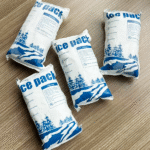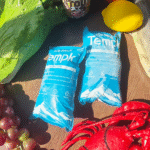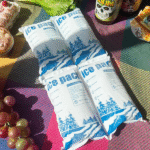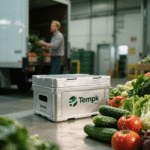How to Choose Affordable Dry Ice Packs for Shipping Perishables?
Shipping perishable goods can be challenging, especially when ensuring they remain at the right temperature during transit. Affordable dry ice packs are one of the most reliable and cost-effective methods for maintaining the required freezing temperatures. In this guide, we will break down how dry ice packs work, how to choose the right one, and why they are essential for your cold chain logistics.
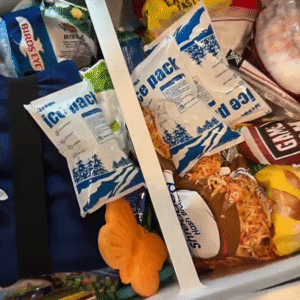
What Are Dry Ice Packs and Why Are They Essential?
Dry ice packs are made from solidified carbon dioxide (CO₂) and serve as a cooling agent for temperature-sensitive goods during transportation. Unlike regular ice, dry ice sublimates directly from a solid to a gas without leaving any liquid residue behind. This unique property makes dry ice packs highly suitable for shipping frozen food, pharmaceuticals, and biological samples. They are preferred over regular ice for their extended cold retention and moisture-free transport.
Benefits of Using Dry Ice Packs
-
Extended Cold Retention: Dry ice can maintain subzero temperatures for 24 to 48 hours, ensuring that sensitive products stay frozen throughout their journey.
-
No Water Mess: As dry ice sublimates, it leaves no liquid behind, preventing water damage, mold growth, and label deterioration.
-
Efficient Cooling: Dry ice packs are denser and provide more cooling power compared to water ice, making them more efficient for heavy-duty cooling.
How Do Affordable Dry Ice Packs Work?
Dry ice works by sublimating at -78.5°C, which is much colder than regular ice. This extreme cold helps preserve frozen goods like seafood, pharmaceuticals, or biotechnological products that require strict temperature control.
-
Sublimation Process: Dry ice moves directly from a solid to a gas state, absorbing heat in the process. This allows it to cool products without leaving behind any moisture, making it ideal for products that are sensitive to water.
-
Ideal for Long-Distance Shipping: Thanks to its efficiency, dry ice is perfect for long shipping durations, particularly for goods that require consistent cooling.
Types of Affordable Dry Ice Packs
When choosing affordable dry ice packs, there are two main types to consider: dry ice sheets and dry ice bricks. Both have their uses depending on the cooling duration and shipment size.
| Type | Cooling Duration | Best For | Price Range |
|---|---|---|---|
| Sheets | 12-24 hours | Small shipments, short trips | Most affordable |
| Bricks | 24-72 hours | Longer shipments, larger loads | More expensive for longer cooling |
How to Calculate the Right Amount of Dry Ice for Your Shipment?
To ensure your products stay cool throughout their journey, correctly calculating the amount of dry ice is essential. Here are general guidelines:
-
Small shipments (e.g., seafood): 1-2 lbs per 24 hours.
-
Larger shipments (e.g., vaccines, biotech): 5-10 lbs per 24 hours.
Factors Affecting Dry Ice Pack Pricing
Several factors can influence the cost of dry ice packs, including:
-
Quantity: Bulk purchases typically lower the per-unit price.
-
Shipping Distance: Longer or international shipments incur additional charges.
-
Packaging: Advanced packaging options like insulated boxes can increase costs.
Where to Find Affordable Dry Ice Packs?
Finding affordable dry ice packs is easy, but cost-effectiveness depends on where you purchase them:
-
Wholesale Distributors: Many manufacturers offer discounts for bulk orders, making it more affordable for larger shipments.
-
Online Retailers: E-commerce platforms often offer competitive prices, especially when bundled with free shipping.
-
Local Suppliers: Check with local cold chain providers for tailored services and pricing.
Benefits of Using Affordable Dry Ice Packs in Cold Chain Logistics
Affordable dry ice packs can improve your cold chain logistics in several ways:
-
Cost-Effectiveness: Compared to custom dry ice shipments, affordable dry ice packs lower overall shipping costs, particularly for shorter transit times.
-
Consistency: Dry ice ensures a consistent, moisture-free cooling environment, which is essential for maintaining the quality of perishable goods.
-
Versatility: Ideal for a range of industries, including food, pharmaceuticals, and biotech, dry ice packs are a reliable solution for businesses of all sizes.
Safety Considerations When Handling Dry Ice
Dry ice, while an excellent cooling agent, can pose risks if mishandled. Here are some key safety tips:
-
Use Gloves: Always wear insulated gloves when handling dry ice to prevent frostbite.
-
Proper Ventilation: Since dry ice sublimates into carbon dioxide (CO₂), which displaces oxygen, always handle and store dry ice in well-ventilated areas.
-
Avoid Sealed Containers: Never store dry ice in sealed containers to prevent the risk of pressure buildup.
2025 Trends in Affordable Dry Ice Pack Usage
As we move into 2025, innovations in dry ice technology are expected to increase efficiency and sustainability in cold chain logistics:
-
Eco-Friendly Packaging: Sustainable materials and recyclable insulation options are becoming more common, aligning with growing environmental concerns.
-
Smart Sensors: IoT-enabled dry ice packs will allow for real-time temperature tracking, providing better monitoring of perishable goods during shipping.
Frequently Asked Questions (FAQ)
Q1: How long do dry ice packs last?
Dry ice packs typically last between 12 and 72 hours, depending on the type of pack and insulation used.
Q2: Are dry ice packs safe to use for food shipping?
Yes, as long as the dry ice is handled correctly and packaged properly, dry ice is safe for shipping food. Ensure proper ventilation to avoid any CO₂ buildup.
Q3: How much dry ice should I use for shipping?
For small shipments like seafood, use 1-2 lbs per 24 hours. For larger shipments, such as vaccines or biotech samples, use 5-10 lbs per 24 hours.
Conclusion
In conclusion, affordable dry ice packs are a critical component of cold chain logistics, offering cost-effective, efficient, and reliable solutions for shipping perishable goods. Whether you’re shipping food, pharmaceuticals, or biotech samples, understanding how to select, use, and calculate the right amount of dry ice will ensure your products remain safe and intact throughout their journey.
Next Steps:
-
Consult with a supplier to determine your exact dry ice needs.
-
Consider purchasing in bulk for cost savings on larger shipments.
-
Stay updated on eco-friendly packaging options to align with sustainability goals.
About Tempk
At Tempk, we specialize in providing cutting-edge cold chain logistics solutions, including affordable dry ice packs. Our products are designed to meet the specific needs of the pharmaceutical, biotech, and food industries. With a focus on cost-effectiveness, reliability, and sustainability, we ensure that your sensitive goods are shipped safely and on time.
Contact Us: Reach out today for a tailored consultation on optimizing your cold chain logistics with affordable dry ice packs.
















